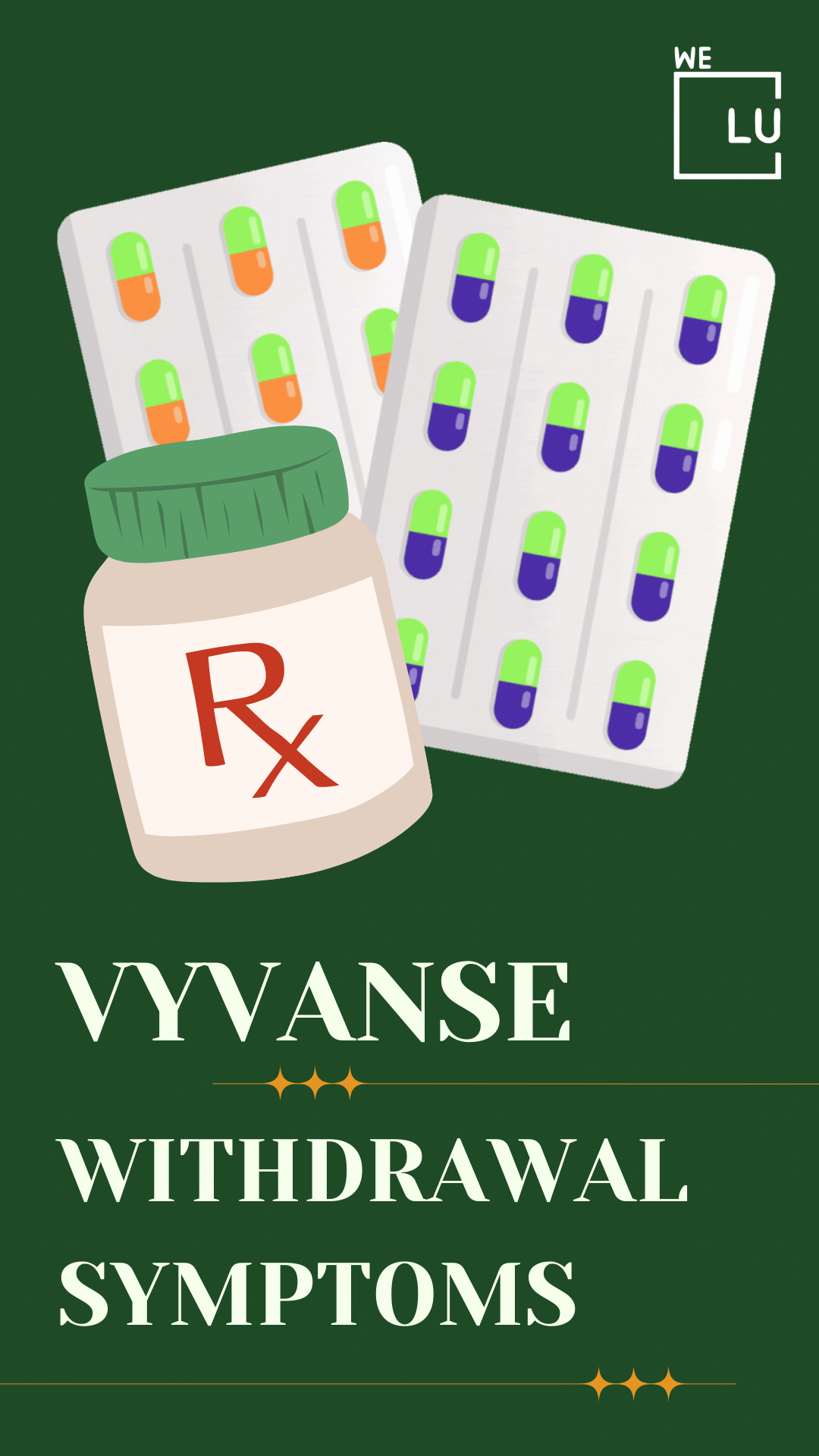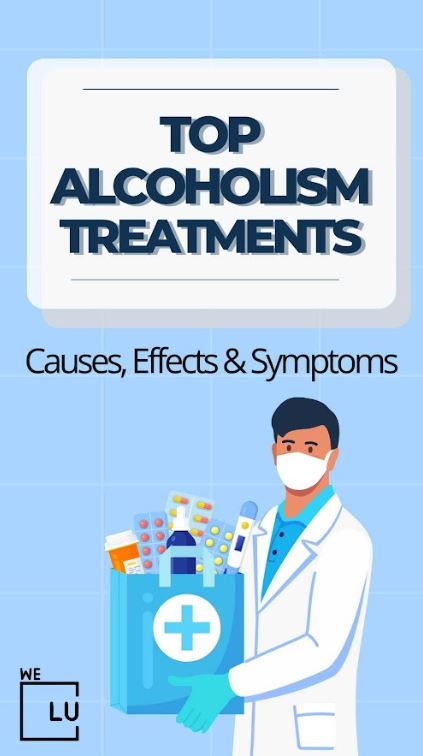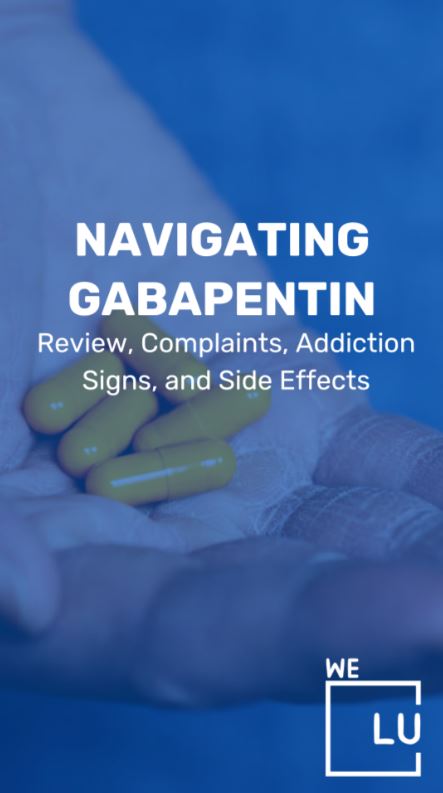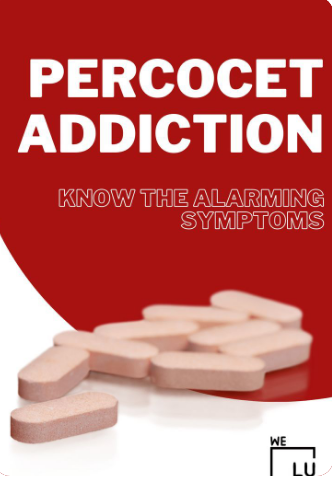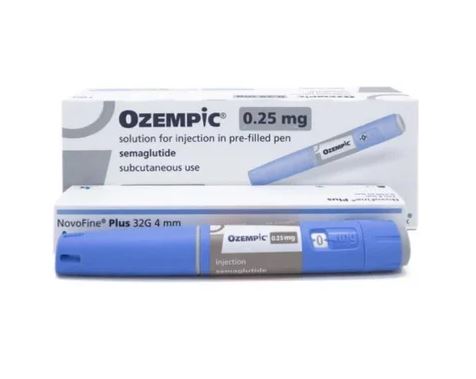Meth Addiction
Meth is a highly addictive stimulant that can lead to addiction even after only one usage. This is mostly due to the drug’s surge of dopamine. Dopamine is a neurotransmitter responsible for eliciting pleasurable experiences and motivation, memory retention, learning, and reward processing. Why is meth so addicting? The surge of dopamine created by meth is far higher than the normal quantity produced in the brain, causing users to continue using the substance to maintain those heightened and pleasurable sensations.
Abusing meth can leave you with lasting physical and mental problems. Here’s what you need to know about this dangerous drug.
What is Meth?
Meth or Methamphetamine, or crystal meth, is a powerful and highly addictive stimulant that may affect your central nervous system. Meth addiction has devastating effects. It can cause lung disorders, kidney damage, hyperthermia, stroke, and cardiac arrest. Oral or dental disease, including meth mouth, was one of the most prevalent medical comorbidities in meth users.
Meth can be smoked, snorted, injected, or orally ingested. People who use meth sometimes combine it with other drugs, such as alcohol or fentanyl (a “speedball”), which can be particularly dangerous and raise the risk of overdose.
The Faces of meth addiction refers to a decline in negative health consequences and facial appearances, such as induced meth addict skin issues leading to facial fat and muscle loss. Probably the most common drug that may result in skin-picking disorder is meth. The meth addiction skin picking often leads to very noticeable open sores, often referred to as “meth sores,” and are due to a combination of physical and psychological side effects related to repeated abuse of meth. Meth sores look like ulcers and open wounds.

How long does meth stay in your system, and how to effectively treat meth addiction? The most effective meth addiction treatment is behavioral therapy, such as cognitive-behavioral and contingency management interventions [1]. The first step in confronting meth addiction is through medically-assisted meth detox, ridding the body of an addictive substance. Meth detox might not be easy, but the benefits of overcoming meth addiction far outweigh the negative side effects of detox.
Meth Classification
Meth has been classified by the U.S. Drug Enforcement Administration (DEA) as a Schedule II controlled substance, which makes it legally available only through prescription.
What Does Crystal Meth Look Like?
Meth and Crytal Meth is a white, odorless, bitter-tasting crystalline powder that easily dissolves in water or alcohol.
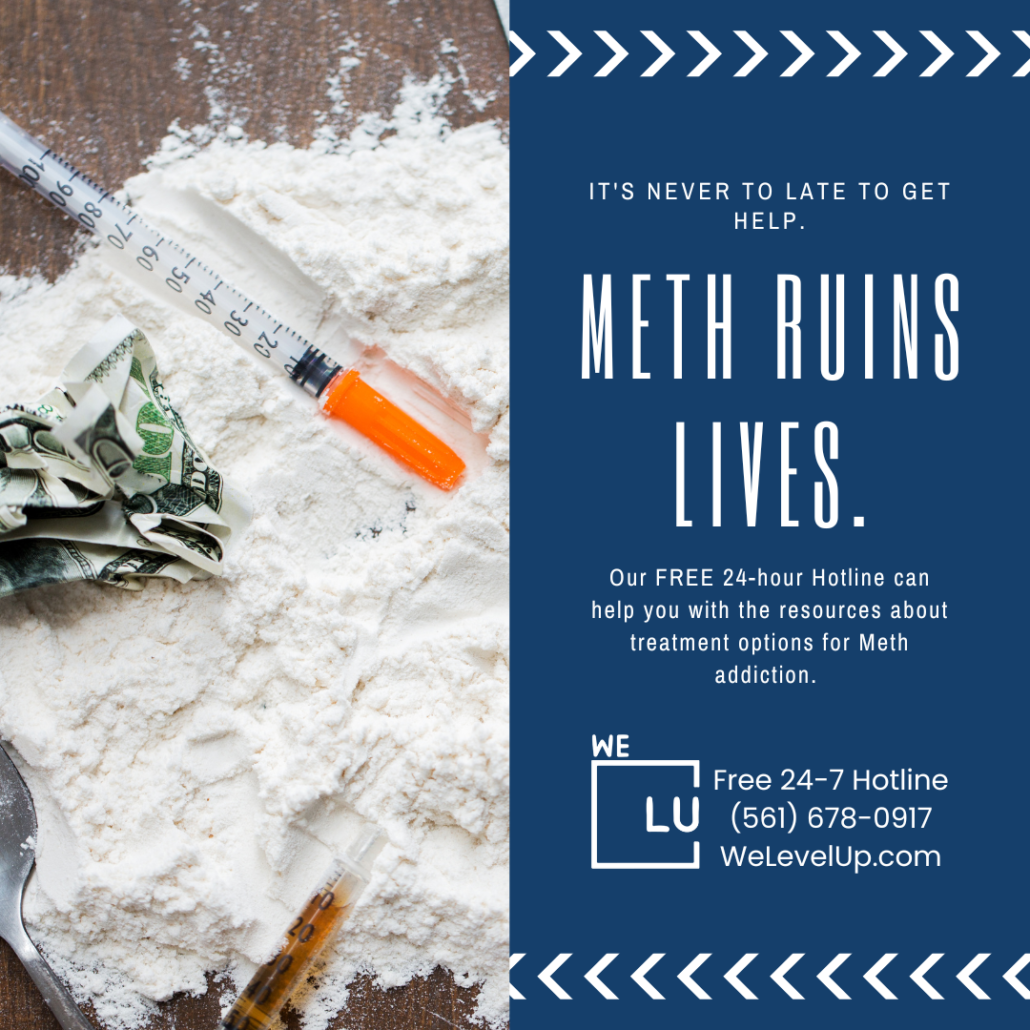
Skip To:
- Meth Addiction
- What is Meth?
- Meth Addiction Recovery Rates & Statistics
- Why Is Meth So Addictive? Facts
- How Addictive is Meth?
- How Does Methamphetamine Affect Your Health?
- Side Effects of Meth Use
- How Long Does Meth Last?
- Effects of Meth Addiction
- Physical Signs of Meth Addiction & Abuse
- Psychological Signs of Meth Addiction & Abuse
- Behavioral Signs of Meth Addiction
- Meth Overdose
- Effects of Meth Withdrawal
- Meth Rehab NJ and Detox Treatment at We Level Up New Jersey
- 10 Most How Addictive is Meth? Frequently Asked Questions
- Quotes About Meth Addiction & Poems About Meth Addiction
Learn More:
How addicting is meth? Meth can cause addiction in as little as one use in some users, people typically use meth and alcohol combination, which in fact, increases the side effects. This is mainly due to the rush of dopamine produced by the drug. Dopamine is a chemical that’s responsible for inducing feelings of pleasure and motivation, memory retention, learning, and reward processing.
Meth Addiction Recovery Rates & Meth Addiction Statistics
According to several studies, relapse occurs between seven and ten months after completion of crystal meth rehab in about 80% of recovering addicts. What percent of meth addicts recover? One meth addiction recovery statistics study showed that people who went through meth detox alone were just as likely to use meth again as users who never received treatment. The percentage of high functioning meth addicts that stay clean and who followed their detox with rehab had more promising results. Crystal meth addiction recovery rate for every 100 people, meth rehab helped 33 stay sober at three months, with this number falling to 14 people remaining sober at one year and six at three years.
The National Institute on Drug Abuse says that long-term methamphetamine abuse has many negative consequences, including addiction. Addiction is a chronic, relapsing disease, characterized by compulsive drug seeking and use and accompanied by functional and molecular changes in the brain. [2] Get the statistics below to find out how many people are addicted to meth? and how many meth addicts recover and overdose? Learning statistics and drug education in rehab facilities develops awareness of possible triggers that may risk current progress toward sobriety.
2.6 Million
Among people aged 12 or older in 2020, 0.9% (or about 2.6 million people) reported using methamphetamine in the past 12 months.
Source: NIDA
1.5 Million
Among people aged 12 or older in 2020, an estimated 0.6% (or about 1.5 million people) had a methamphetamine use disorder in the past 12 months.
Source: NIDA
23,837
In 2020, approximately 23,837 people died from an overdose involving psychostimulants with abuse potential other than cocaine (primarily methamphetamine).
Source: NIDA
Why Is Meth So Addictive? Facts
Why is meth addicting? The explanation for why meth is so addictive is that it stimulates the production of dopamine in your brain. This chemical makes people feel upbeat, as though they are being physically and emotionally rewarded for using it. After using meth, a functioning meth addict might undergo severe symptoms, but find it intensely difficult to stop taking the drug because your body continues to crave this rewarding feeling.
Street Terms for Methamphetamine
- Beannies
- Brown
- Chalk
- Chicken feed
- Cinnamon
- Crink
- Crypto
- Fast
- Getgo
- Methlies quik
- Mexican crack
- Redneck cocaine
- Rock
- Tick tick
- Wash
- Yellow powder
Overcoming Meth Addiction DEA Drug Fact Sheet
How addictive is crystal meth? and is meth physically addictive? Crystal meth is a highly addictive stimulant that can cause addiction in as little as a single use. This is mainly due to the rush of dopamine produced by the drug. Methamphetamine withdrawal can cause different acute and post-acute symptoms in different people, causing them to be physically dependent to the drug. Below is the DEA facts sheet readily available for meth addiction help and awareness.

Get Your Life Back
Find Hope & Recovery. Get Safe Comfortable Detox, Addiction Rehab & Mental Health Dual Diagnosis High-Quality Care at the We Level Up Treatment Centers Network.
Hotline (877) 378-4154How Addictive is Meth?
Meth increases the amount of the natural chemical dopamine in the brain. Dopamine is involved in body movement, motivation, and reinforcement of rewarding behaviors. The drug’s ability to rapidly release high levels of dopamine in reward areas of the brain strongly reinforces drug-taking behavior, making the user want to repeat the experience.
Meth causes an intense elevated or euphoric mood that is much stronger than cocaine. Experiencing these unnatural dopamine levels causes a strong desire to continue using the drug. It becomes addictive because your body experiences intense cravings to maintain the euphoric state, which often results in constant redosing and binge-like behavior to achieve that goal.
How Does Methamphetamine Affect Your Health?
Methamphetamine affects your brain
Methamphetamine causes changes in the brain circuits that control reward, stress, decision-making, and impulse control, making it more and more difficult to stop using even when it is having adverse effects on your life and health. Frequent use also can lead to tolerance and withdrawal, so you need more of the drug to feel normal. Additional effects of using methamphetamine can include anxiety and depression, chronic fatigue, paranoid or delusional thinking, and severe psychological issues.
Methamphetamine affects your body
Methamphetamine use increases heart rate, blood pressure, and risk of stroke. Other adverse consequences of long-term methamphetamine use are extreme weight loss, severe dental problems, and skin sores faces of meth addiction caused by scratching. Methamphetamine use affects the levels of dopamine in your brain. Dopamine is a neurotransmitter. It affects, among other things, movement, motivation, emotions, and feelings of pleasure. Because meth causes a flood of dopamine to the brain, the natural supply gets depleted. Thus, activities that would increase pleasure may no longer do so. This can lead to depression.
Methamphetamine affects your self-control
The stages of meth addiction can cause aggression, violent behavior, and loss of contact with reality. Meth addicted brain receptors become overwhelmed. The brain responds by producing less dopamine or eliminating dopamine receptors—an adaptation similar to turning the volume down on a loudspeaker when noise becomes too loud.
Methamphetamine affects more than the user
Methamphetamine use impacts the user’s family and friends. Children found in meth labs may experience emotional, behavioral, and cognitive problems. In addition, the chemicals used to produce meth can cause fires and explosions, produce toxic vapors, and damage the environment.
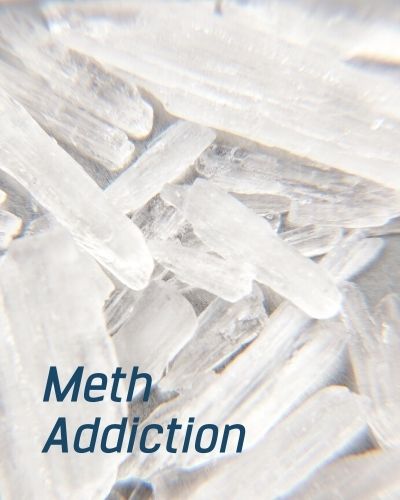


Before and After Meth Addiction Images
The following before and after pictures of meth addicts are courtesy of publically made available sheriff’s department arrest files from individuals suffering from meth addiction before and after. For more “pictures of a meth addict,” “meth addicts pictures,” “crystal meth addicts images,” “meth addiction pictures before and after,” or “meth addiction pics” visit www.dea.gov.
Why do meth addicts have sores? Even light methamphetamine use can cause widespread acne due to the drug’s effects of dry meth addict face skin and extreme itchiness. Coupled with the common sensory hallucination factor of ‘bugs crawling beneath the skin,’ this often promotes obsessive scratching, picking, and resulting in many small sores and facial scarring.
The pale meth addiction faces skin color can be explained by physical stress and frequent illnesses common to meth addicts, which are caused by the drug weakening the immune system. Smoking any type of drug actually affects the skin, just like leather, causing the face of meth addict skin to wrinkle and gain a rough, coriaceous texture.
Severe tooth decay and gum disease are other consequences of meth use. “Meth mouth” can cause the teeth to break or fall out, affecting a person’s oral health and appearance.
Key findings about treating meth addiction courtesy of the National Center for Biotechnology Information or NCBI. [3]
- Only about 1 in 10 people with a substance use disorder receive any type of specialty treatment. The great majority of treatment has occurred in specialty substance use disorder treatment programs with little involvement by primary or general health care. However, a shift is occurring to mainstream the delivery of early intervention and treatment services into general healthcare practice.
- Well-supported scientific evidence shows that medications can be effective in treating serious substance use disorders, but they are under-used. The U.S. Food and Drug Administration (FDA) has approved three medications to treat alcohol use disorders and three others to treat opioid use disorders. However, an insufficient number of existing treatment programs or practicing physicians offer these medications. To date, no FDA-approved medications are available to treat marijuana or cocaine, and no approved medication for meth addiction, or other substance use disorders, with the exception of the medications previously noted for alcohol and opioid use disorders.
- Supported scientific evidence indicates that substance misuse and substance use disorders can be reliably and easily identified through screening and that less severe forms of these conditions often respond to brief physician advice and other types of brief interventions.


These images of “meth addict before after” are courtesy of the U.S. Department of Justice and made available for meth awareness. For more pics of meth addicts before and after, “female meth addict,” “meth addict woman,” “picture of a meth addict mugshot,” and “meth addiction before and after pics,” visit www.justice.gov and visit www.dea.gov.
Get Help. Get Better. Get Your Life Back.
Searching for Accredited Drug & Alcohol Rehab Centers Near You? Or Mental Health Support?
Even if you have failed previously, relapsed, or are in a difficult crisis, we stand ready to support you. Our trusted behavioral health specialists will not give up on you. Call us when you feel ready or want someone to speak to about therapy alternatives to change your life. Even if we cannot assist you, we will lead you wherever you can get support. There is no obligation. Call our hotline today.
FREE Addiction Hotline – Call 24/7Side Effects of Meth Use
Meth has a great influence even in small quantities because its effects are like those of other stimulant drugs like cocaine. Moreover, side effects may include:
- Increased breathing
- Lack of appetite
- Irregular heartbeat
- Increased physical activity and fidgeting
- Lack of inhibitions
- Confusion
- Delusions
- Hallucinations
- Paranoia
- Increased alertness and wakefulness
- High blood pressure
- Feeling exhilarated
- Feeling confident and empowered
- Euphoria
- Dulled or “blunted” emotions
- Increased sexual arousal
- Agitation
- Talkativeness
- Increased sociability
- Increased aggression
- Bizarre behavior
- Lack of social awareness
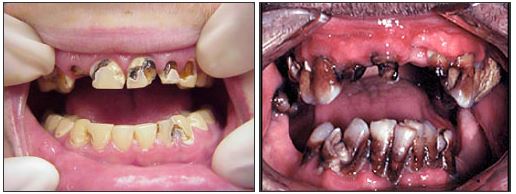
How Long Does Meth Last?
The experience of “high” from meth only lasts five to 30 minutes then, the lingering effects can last up to 12 hours. Consequently, it causes difficult emotional and physical symptoms of a meth addict, such as depression and insomnia. As a result, meth addiction often follows a pattern of bingeing on the drug for several days at a time, followed by a crash.
Certainly that the short duration of the drug’s euphoric effects may cause you to reuse the substance, which can increase your tolerance to meth. As a result of your tolerance to the drug, you will need to take higher doses to achieve the desired effects. In fact, some users are smoking or injecting meth to experience a stronger, more immediate high.
Effects of Meth Addiction
Why is meth addictive? Most users try to maintain the high by taking more of the drug. In some cases, people indulge in a form of binging known as a “run,” foregoing food and sleep while continuing to take the drug for up to several days. [2]
The short-term effects of meth according to the SAMHSA [3] include the following:
- Even taking small amounts of meth can cause harmful health effects such as irritability
- Increased blood pressure and body temperature
- Faster breathing
- Rapid or irregular heartbeat
- Loss of appetite, disturbed sleep patterns, or nausea
- Erratic, aggressive, or violent behavior
Drug abuse of meth can lead to many damaging, long-term health risks, even when people stop taking meth, including these symptoms of meth addiction:
- Permanent damage to the heart and brain
- High blood pressure leads to heart attacks, strokes, and death
- Liver, kidney, and lung damage
- Anxiety, confusion, and insomnia
- Paranoia, hallucinations, mood disturbances, delusions, or violent behavior (psychotic meth addict symptoms can sometimes last for months or years after meth use)
- Intense itching, causing the faces of meth addicts skin sores from scratching
- Premature osteoporosis
- Severe dental problems
Physical Signs of Meth Addiction & Abuse
A painful reality of substance use is that others will often not realize it until it reaches the abuse or addiction phase. Unfortunately, meth has such a high addiction potential that it is relatively easy for a regular user to slip from use to abuse to addiction.
Physical signs of meth use will emerge whether the person is new to the drug or becoming increasingly dependent on it. The following are some of the physical signs or dangers associated with meth abuse:
- A thinning, frail body
- Facial acne or sores
- Rotted “meth addicts teeth” (“meth mouth”)
- A droopy quality to the facial skin
- Convulsions
- Liver damage
- Stroke
- Lowered immunity/susceptibility to infectious disease
- A dramatic increase in body temperature
- Increased libido
- Intense scratching
- Death
Psychological Signs of Meth Addiction & Abuse
What makes meth addictive? or why do people get addicted to meth? Meth is connected with a lot of different psychological side effects. When meth is used, there is an initial feeling of euphoria because of this drug’s ability to increase dopamine levels in the brain. Dopamine is one of the main chemical messengers in the brain’s reward system. Illegal drugs, such as meth, that activate the brain’s reward circuitry have a high potential for addiction in general.
But dopamine has functions in the brain other than pleasure alone. Dopamine is also involved in learning ability and memory. Ongoing meth addiction will constantly flood the brain with dopamine, which over time, will form an imbalance in the brain’s natural dopamine levels and dopamine-involved operations. Consequently, those who abuse meth in the long term may experience memory problems, an inability to learn new motor skills and other tasks, and impaired visual memory.
Meth addiction can cause psychosis in some users. Features of meth-induced psychosis include auditory and visual hallucinations, delusions, paranoia, and irritability. Intense scratching is a physical side effect that is ingrained, in some cases, in psychosis. People who experience meth-induced psychosis may perceive bugs crawling all over their skin, and persistent scratching and picking are ways to relieve this perceived pain. As a result of the picking and scratching, skin abrasions and rashes will likely be developed.


First-class Facilities & Amenities
World-class High-Quality Addiction & Mental Health Rehabilitation Treatment
Rehab Centers TourRenowned Addiction Centers. Serene Private Facilities. Inpatient rehab programs vary.
Addiction Helpline (877) 378-4154Proven recovery success experience, backed by a Team w/ History of:
15+
Years of Unified Experience
100s
5-Star Reviews Across Our Centers
10K
Recovery Success Stories Across Our Network
- Low Patient to Therapist Ratio
- Onsite Medical Detox Center
- Comprehensive Dual-Diagnosis Treatment
- Complimentary Family & Alumni Programs
- Coaching, Recovery & Personal Development Events
Behavioral Signs of Meth Addiction
Substance use, whether it’s meth or other addictive stimulants, has a way of quickly transforming from a recreational choice to a major life preference. When people prioritize drug use, it is generally only a matter of time before work, school, or relationship problems arise. Although users will attempt to hide the misuse in the beginning stages of meth use, a typical side effect of meth addiction is that the person using no longer cares about what other individuals think because the meth abuse has become all-important.
This level of self-involvement with meth, to the exclusion of important obligations and relationships, is itself one of the most vital behavioral signs of addiction. Many concerned individuals will not want to approach individuals they suspect are using meth without evidence. As a result, family members may decide to search for meth-related paraphernalia. In some cases, drugs may be found; only paraphernalia may be found in other cases. Although finding a drug would seem like a “smoking gun,” the paraphernalia alone is highly compelling evidence that should not be ignored. Even though meth and paraphernalia are not time-stamped, they are very likely to be a sign of present drug use.
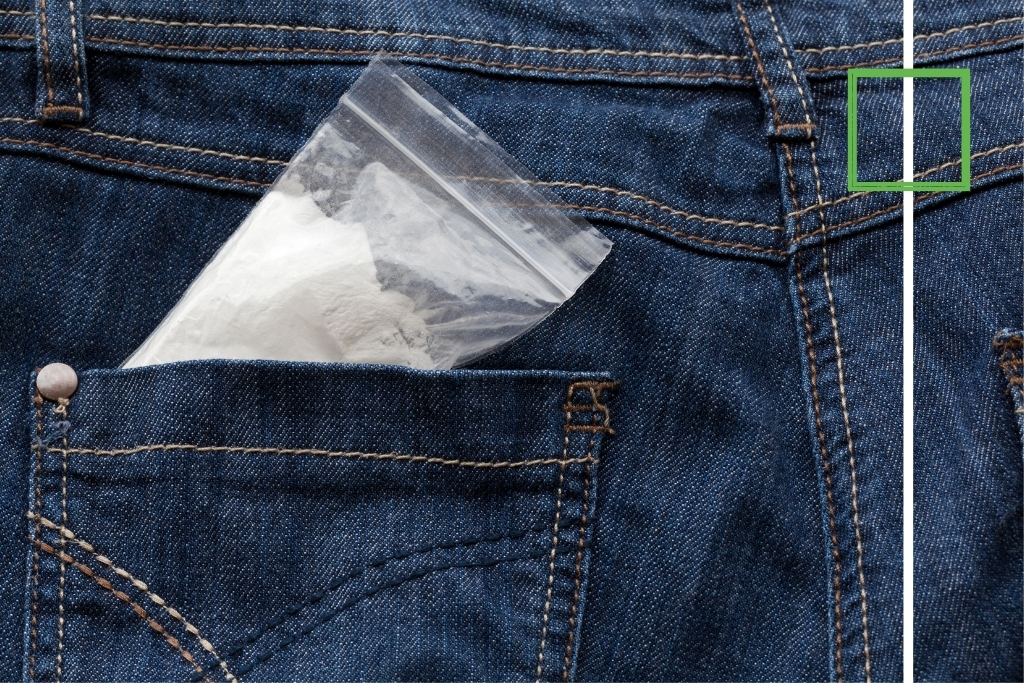
Meth Overdose
Getting addicted to crystal meth is a serious worldwide public health problem with major medical, psychiatric, socioeconomic, and legal consequences. According to data from the 2017 National Survey on Drug Use and Health (NSDUH), over 14.7 million people (5.4 percent of the population) have tried methamphetamine at least once.
Meth Overdose Signs and Symptoms
If someone you know is showing meth addict behaviors, getting familiar with the signs of an overdose could one day save a life.
Common symptoms of a meth overdose include:
- Chest pain
- Arrhythmias
- Hypertension or hypotension
- Difficult or labored breathing
- Agitation
- Hallucinations
- Psychosis
- Seizures
- Rapid or slow heartbeat
- Hyperthermia
If someone undergoes a meth overdose, their odds of recovery depend on how much of the drug they took and how quickly they receive treatment. Coming back from a meth overdose is possible, but it is paramount that the person who overdosed receives professional medical attention immediately. Since a meth overdose is a clear sign of an abuse issue, professional addiction treatment should follow once the person is stabilized
Effects of Meth Withdrawal
Research has shown that meth withdrawal follows a predictable pattern. Firstly, symptoms appear within 24 hours after the last dose. In fact, these symptoms peak after 7 to 10 days of abstinence. And then, they disappear within 14 to 20 days of abstinence. [3]
Further meth withdrawal symptoms include the following:
- Constipation
- Diarrhea
- Headaches
- Red, itchy eyes
- Joint pain
- Clammy skin
- Hyperventilation
- Irregular heartbeat
- Shaking
While going through meth withdrawal during detox, people often become angry, nervous, or anxious. Some may experience severe mental health problems such as depression or meth psychosis. [4] You may also feel intense cravings for the drug often because of the discomfort you feel without the effects of the drug.
Given that, you should undergo detox in a supervised treatment center to help you ease these withdrawal symptoms. Detoxification is a process aimed at helping you stop taking meth as safely and as quickly as possible.
World-class, Accredited, 5-Star Reviewed, Effective Addiction & Mental Health Programs. Complete Behavioral Health Inpatient Rehab, Detox plus Co-occuring Disorders Therapy.
CALL (877) 378-4154End the Addiction Pain. End the Emotional Rollercoaster. Get Your Life Back. Start Drug, Alcohol & Dual Diagnosis Mental Health Treatment Now. Get Free No-obligation Guidance by Substance Abuse Specialists Who Understand Addiction & Mental Health Recovery & Know How to Help.
Meth Rehab NJ and Detox Treatment at We Level Up New Jersey
Clearing meth from the body and overcoming withdrawal symptoms is the goal of detox, which is the first step of treatment for meth addiction. Here at We Level Up NJ, a comprehensive team prescribing medications can alleviate your withdrawal pains while monitoring your health 24 hours during the detox. We prioritize your safety and comfort because this is a fragile and challenging time for you.
Some of the many modalities applied and practiced within our residential treatment for meth addicts facility are:
Once detox is complete, a new doorway in meth addiction medication opens up, which is referred to as a residential level of care. Our residential care program slowly and effectively introduces the individual into an atmosphere of therapeutic growth, marked by master’s level therapists, clinicians, group counselors, psychiatrists, and a community of like-minded individuals with the same aim: to attain sobriety and live a great life.
Searched for “meth addiction treatment near me?” or how to help meth addicts? We Level Up NJ treatment tailors the program to the individual and the individual to the program of recovery. We begin by assessing our client’s history of mental health, drugs, and alcohol-related past. The needs of each patient are specific and personalized because we aim to provide comprehensive support for mental health, addiction, and dual diagnosis treatment, such as meth and sex addiction, ADHD, and depression. We Level Up meth addiction treatment centers have a supportive environment designed accordingly to give patients 24-hour care for sobriety. Most importantly, we hope to have our patients live comfortably within the facility during this crucial and fragile time.
We prioritize removing temptations for relapse and applying an air of recovery into every component of the treatment timeline, including meth addiction treatment.
We Level Up NJ meth addiction rehab finds that when functional meth addicts and clients are living in a supportive community, especially during their early recovery process, they can truly focus on what matters most: their recovery. Call our meth addiction hotline, available 24/7. Each call is private and confidential.

Experience Transformative Recovery at the We Level Up Treatment Center.
See our authentic success stories. Get inspired. Get the help you deserve.



Start a New Life
Begin with a free call to an addiction & behavioral health treatment advisor. Learn more about our dual-diagnosis programs. The We Level Up treatment center network delivers various recovery programs at each treatment facility. Call to learn more.
- Personalized Care
- Caring Accountable Staff
- World-class Amenities
- Licensed & Accredited
- Renowned w/ 5-Star Reviews
We’ll Call You
10 Most How Addictive is Meth? Frequently Asked Questions
-
What percentage of meth addicts stay clean?
Between 40% and 60% of addicts will inevitably relapse. This figure, however, does not represent every person who has completed treatment. It is important to understand the high probability of relapse and learn the proper tools to maintain sobriety. Attending “meth addicts anonymous” meetings can greatly help to avoid these relapses.
-
How is meth addictive?
Meth is a highly addictive stimulant that can cause addiction in as little as a single use. This is mainly due to the rush of dopamine produced by the drug. The need for speed meth addicts leads them to seek the drug immediately again. A person addicted to crystal meth is using a paraphernalia set, or mixing the drug with other substances to increase the “high.”
-
What are the signs of a meth addiction?
Long-term methamphetamine abuse has many negative consequences and meth addiction symptoms and meth addiction signs. Addiction is a chronic, relapsing disease, characterized by compulsive drug seeking and use and accompanied by functional and molecular changes in the brain.
-
How to help a meth addict?
Treatments for meth addiction can help someone stop using meth and get their life back on track. But even after getting crystal meth addiction treatment, it’s common to have a slip-up and start using a drug again.
-
Is crystal meth addictive?
Yes. On the street, it’s called, “glass,” “meth,” “shards,” ice,” or “Tina,” among those who make, distribute, and use this highly addictive drug. A person addicted to crystal meth is using a brainly therapeutic dose to produce euphoric highs.
-
How long does it take to get addicted to meth?
Meth addict signs are scary, dangerous, and lethal. Simply put, the use of meth in any amount is something to be concerned about. Even a single use can cause signs of meth addiction in adults.
-
What percentage of meth addicts recover?
One study showed that people who went through meth detox alone were just as likely to use meth again as users who never received rehab for meth addiction treatment. The percentage of meth addicts that stay clean and who followed their detox with rehab had more promising results. For every 100 people, meth rehab helped 33 stay sober at three months, with this number falling to 14 people remaining sober at one year and six at three years.
-
Why do meth addicts dig holes?
Most of the time, meth addicts digging is related to psychosis because they’re seeing something on their skin that isn’t there.
-
How to treat meth addiction?
Addiction to meth is one of the hardest addictions to overcome. Still, residential meth addiction treatment centers and facilities can offer the intensive detox and multifaceted recovery from meth addiction treatment plans meth addicts need before they can begin putting their lives back together.
-
Why do meth addicts have bad teeth?
This dangerous drug can take a horrible toll on many parts of your body, including your teeth and gums. Meth addict teeth decay, rotting gums, and other side effects are results of meth use. However, meth mouth is far from the worst side effect of meth abuse. Aside from the cosmetic detriments, methamphetamine as a substance derails people’s lives and leaves many feeling hopeless and destitute. In addition to the derailment mentioned above, it also has a tragic tendency to shorten those lives down to about five or seven years.
Quotes About Meth Addiction & Poems About Meth Addiction
Meth Addiction Quotes
- “People often say that motivation doesn’t last. Neither does bathing. That’s why we recommend it daily.” – Zig Ziglar
- “Success is the sum of small efforts, repeated day in and day out.” – Robert Collier
- “Tomorrow is the most important thing in life; it comes to us at midnight very clean. It’s perfect when it arrives, and it puts itself in our hands. It hopes we’ve learned something from yesterday.” – John Wayne
- “If you can quit for a day, you can quit for a lifetime.” – Benjamin Alire Sáenz
- “Fall seven times, stand up eight.” – Japanese proverb
- “Either you run the day, or the day runs you.” – Jim Rohn
Meth Addiction Stories & Famous Meth Addicts
Is it possible to fully recover from addiction? Yes, addiction is a treatable disorder. Research on the science of addiction and the treatment of substance use disorders has led to the development of research-based methods that help people to stop using drugs and resume productive lives, also known as being in recovery. Many who went through drug inpatient rehab centers shared different success stories, you can also build your own path to recovery and create your own drug-free life. Many shows also portray meth use, such as Breaking Bad meth stories.
Meth Addiction Books
One of the books that can guide you in overcoming substance abuse is “Overcoming Crystal Meth Addiction: An Essential Guide to Getting Clean.” In Overcoming Crystal Methamphetamine Addiction, one of the few books about meth addiction to address the topic for a general audience, Dr. Steven Lee, MD, a psychiatrist who specializes in crystal meth addiction, offers a complete guide to the drug, its effects, and how to overcome it.
Based on extensive scientific and social research and drawing from his professional experience, he covers everything from the definition and history of crystal meth to the physical and psychological effects; from dealing with the addictive personality to helping a friend or family member cope with it.
He focuses on understanding rather than outright condemnation of the drug, and empathetically covers all of the crucial questions: What is crystal meth? How is it made? How does it affect the body? How do you know if you’re addicted to it? How do you stop using it? What if you don’t want to stop? If you are going to use CM anyway, how can you minimize the damage? What if you quit but slipped and used again?
Songs About Meth Addiction & Meth Addiction Poems
One of the meth addict poems that can inspire individuals battling drug addiction is “Meth you won’t be my death” by Deborah Olson, Inspirational Speaker
“As I sit here and silently wait I can only think this isn’t love it must be hate
I’ve been lost in your tantalizing charms
And all I want to do is feel you in my arm
when I close my eyes nightmares only terrorize I wake in cold sweats violent shakes and with a heart that only knows how to break
Best of friends we used to be back when I was young happy and free
Now it seems you only enjoy to hunt taunt and terrorize me
I longed for you every moment
I begged for you on bended knee
I crave for you all the time
God please give me the strength to break free
I’m sure there was a time before you and me
Those days have been whipped my memory
I’ve heard people say there’s no way to break free that you’ll eventually be the death of me
I put my foot down here and now you will not hold my hand down into the ground you will not be the Spade they used to dig my hole or the dirt they cover me with when I’m done and cold
I will live longer than just 33 meth you will not be the death of me.”
Search We Level Up NJ / Detox & Mental Health Topics & Resources
Sources:
[1,2] Methamphetamine – National Institute on Drug Abuse
[3] CHAPTER 4EARLY INTERVENTION, TREATMENT, AND MANAGEMENT OF SUBSTANCE USE DISORDERS – National Center for Biotechnology Information/NCBI
[4] Meth – Substance Abuse and Mental Health Service Administration (SAMHSA)
[5] Methamphetamine Misused – National Institute on Drug Abuse
[6] https://www.samhsa.gov/meth – Substance Abuse and Mental Health Service Administration
[7] McLellan AT. Substance Misuse and Substance Use Disorders: Why do they Matter in Healthcare? Trans Am Clin Climatol Assoc. 2017;128:112-130. PMID: 28790493; PMCID: PMC5525418. With Drug Addiction Quotes and related sobriety quotes[8] 101 Motivational Quotes for Recovering Addicts – and related drug addiction quotes plus sobriety quotes – WeLevelUp.com
[9] Co-Occurring Dual Diagnosis Treatment – with related drug addiction quotes plus sobriety quotes – We Level Up Florida
[10] 100 Sobriety Anniversary Quotes -drug addiction quotes plus sobriety quotes – WeLevelUp.com
